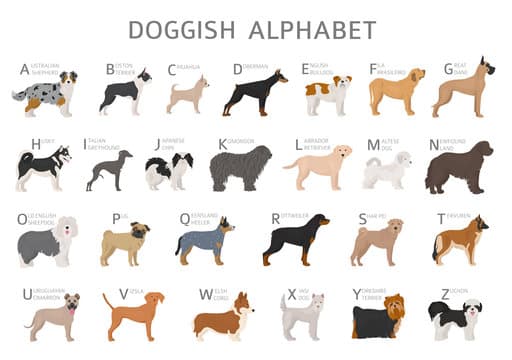Longlivedog.com – When you’re thinking about getting a dog, there are many things to consider. But one of your most important decisions is which breed to get. Choosing the right breed for your lifestyle is critical, as each dog has unique personality traits and behavioural quirks.
In this dog education blog, we will look at the different types of dogs and their characteristics so that you can make an informed decision when choosing your first pet. We will also provide tips on choosing the right breed for you.
Types of Dogs
There are many different types of dogs, each with its personality and temperament. Whether you’re looking for a friendly lap dog, a working breed, or something in between, here’s a guide to the most common types of dogs.
Poodle
The poodle is one of the most popular breeds of dogs. They are friendly and playful but also have a high level of energy. The poodle might be a good choice if you’re looking for a dog that will be comfortable hanging around other people and pets.
Dalmatian
The Dalmatian is another active breed of dog known for its large size and impressive speed. They make great family pets because they are docile enough to be around children and have enough energy to keep them entertained.
Beagle
The Beagle is known for its intelligence and gentle nature. They make great family pets because they are loyal and easy to train. The Beagle might be a good choice if you’re looking for an active breed that won’t require as much exercise as some others.
What to Consider When Choosing a Dog
There are many factors to consider when choosing a dog, but here are a few things to keep in mind:
- Age: Puppies need time to adjust to their new home and new family, so choosing a dog that is age-appropriate for your lifestyle is essential. A young puppy may not be ready for a full-time home, while an older dog may not be able to handle the excitement of a new pet.
- Size: Not all dogs are the same size, so it’s essential to ensure you find the right fit for your household. Some breeds need plenty of room to run and play; others may be happy living in a small apartment.
- Activity level: Some dogs are more active than others; if you like to stay most of the time indoors, you should look for a low-energy breed. On the other hand, if you’re an outdoor enthusiast, consider a more active breed like a Labrador retriever or golden retriever.
- Personality: Like humans, there are different personalities within different breeds of dogs. For example, some species are known for being loyal and friendly; others may be more independent and stubborn. Understanding what kind of personality you’re looking for is essential before deciding about getting a dog.
The Best Time to Get a Dog
When choosing a dog, the best time is any time. However, some general things to keep in mind will help you choose the right dog for you.
First and foremost, consider your lifestyle. If you’re an active person who likes walking or running, there may be better options than a small dog. On the other hand, if you fancy staying at home and don’t have much time for exercise, a giant breed might be your style.
Second, think about what kind of personality you’re looking for in your new pet. Do you want a quiet dog that won’t bother its neighbours? Or are you more of a do-er who likes a high-energy pup?
And finally, take into account your budget. How much do you want to spend on a dog? And what breeds are available within your budget? There are dozens of different species of dogs, so deciding which one is perfect for you is challenging. Consider narrowing your options by reading up on specific breeds and visiting shelters or rescue organizations with adoptable dogs to see which ones appeal to you most.
The Different Breeds of Dogs
There are over 150 dog breeds in the world, each with its personality and characteristics. When choosing your first dog, it’s essential to consider your lifestyle and the type of dog best fits into it. Here are three tips for choosing the right dog breed for you:
If you’re an active person…
Suppose you’re an active person who wants a dog that can keep up with you on walks, consider a retriever or a German shepherd. These dogs are very athletic and love chasing after things, making them great companions for people who like to be outside.
If you’re more of a homebody…
If you prefer staying inside most of the time, consider a soft-coated wheaten terrier or a Bichon Frise. These dogs are small but fiercely loyal companions who make great house pets. They’re also known for being gentle with children and other pets, making them a good choice if you have concerns about having a guard dog.
How to Choose Your First Dog Breed
Choosing a dog breed is an important decision you’ll likely make at some point in your life. There are many factors to consider when choosing your first dog, from size and energy level to personality and Shedding. Here are five tips for choosing the right dog breed for you.
Evaluate your lifestyle
Before deciding what breed of dog would be best for you, it’s essential to consider your lifestyle. Are you happy living with a small, low-key breed, or would a more giant, more active breed be better? Do you have children? If so, will their activities (and potentially destructive behavior) be compatible with the type of dog you choose?
Consider size and energy level
Another critical factor to consider when choosing a dog is its size and energy level. Some dogs are naturally more active than others, so if this is an essential factor for you, it might be worth considering one of these breeds. Alternatively, a smaller breed might be better suited for you if you’re not as energetic as most dogs and prefer something that isn’t always running around. Make sure to properly prepare yourself for how much exercise your new pet will require!
Consider personality traits
One of the most important considerations when choosing a new pet is its personality. Do you want a stay-at-home pet or someone who loves going on walks? Is there an activity or trait that you specifically wish to your dog
What to Look for in a Dog Breed
When choosing a dog breed, there are many things to consider. The following are five key factors to keep in mind when choosing a new canine companion:
- Size and Weight: Make sure you choose a dog that is the right size for your lifestyle and personality. Some breeds are more suited for smaller homes, while others may be better suited for larger ones. It’s essential to weigh the pros and cons of each species before making your decision.
- Behavior: Look for a dog that is generally friendly and well-behaved. Do not purchase a dog if you have concerns about his/her temperament; research each breed thoroughly before making your purchase.
- Trainability: Check out the individual trainability of each breed before making your purchase. Some breeds are harder to train than others, so be prepared to invest time and effort into training your new pup!
- Shedding: Consider whether or not you expect the dog to shed heavily or if he or she will only produce light hair throughout their lifetime. Some breeds suffer more from shedding than others, so it’s important to research this factor before making your purchase decision.
- Medical Requirements: Be aware of any medical requirements specific to the breed you’ve chosen, as some may require specific medications or treatments that would not be suitable for other dogs in the family.
Choosing the Right Age to Get a Dog
When it comes to choosing the right age to get a dog, there is no definitive answer.
Some people choose to get a puppy when they’re first starting out as dog-owners, while others wait until their pet is older and more experienced. Ultimately, the best decision depends on your lifestyle and what kind of dog you’re looking for.
Whether you have kids or not, a younger pup may not be able to properly socialize with other children and could be prone to getting into trouble. On the other hand, an older dog may become more congested due to seniority and may require more care than a younger one. Ultimately, it’s important to do your research and talk to your family and friends about their experiences with different types of dogs before making a decision.
How Much Money to Spend on a Dog
There are a lot of factors to consider when choosing your first dog, but one of the most important is how much money you’re willing to spend. Here are four ranges of costs for different types of dogs and what you can expect to pay for each. Low-cost dogs: $50-$100
- Mid-priced dog breeds: $100-$200
- Expensive dog breeds: more than $200
- Low-cost dogs: These dogs typically cost between $50 and $100, and include breeds like German Shepherds, Labrador Retrievers, Golden Retrievers, Bichons Frises, and Beagles. They make great family pets and are usually very friendly and loving. Mid-priced dog breeds: These dogs typically cost between $100 and $200, and include breeds like Boston Terriers, Welsh Corgis, Boxers, French Bulldogs, Shih Tzus, Poodles, Daikon radishes.
They make excellent pets for single people or couples who don’t want a big dog or a high-energy breed. Expensive dog breeds: These dogs typically cost more than $200, but some affordable options include English bulldogs (around $150), Welsh corgis ($175), Belgian Malinois ($300), Australian shepherds ($450). They make great family pets if you have the space for one or can afford the monthly expenses.
Conclusion
Choosing your first dog breed can be a daunting task, but it’s important to take the time to do research and find the perfect dog for you. There are so many different types of dogs available today, and it can be hard to decide which one is right for you. We’ve compiled a list of some tips on how to choose your first dog breed, including information on what factors to consider when choosing a new pet, as well as our top five tips for choosing the perfect pup.
Hopefully this will help you make an informed decision and find the perfect canine companion.









